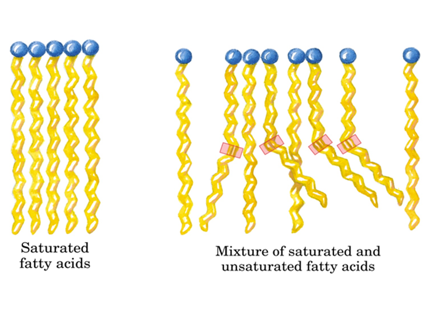

A second class of proteins is associated with the polar surfaces of the bilayer and with the intrinsic membrane proteins. These so-called integral, or intrinsic, membrane proteins have amino acids with nonpolar side chains at the interface between the protein and the nonpolar central region of the lipid bilayer. Some protein components are inserted into the bilayer, and most span this structure. Some intrinsic proteins present sugar side chains on the cell's outer surface. Extrinsic proteins are loosely bound to the hydrophilic (polar) surfaces, which face the watery medium both inside and outside the cell.

Intrinsic proteins penetrate and bind tightly to the lipid bilayer, which is made up largely of phospholipids and cholesterol and which typically is between 4 and 10 nanometers (nm 1 nm = 10 −9 metre) in thickness. The lipid bilayer structure forms an impermeable barrier for essential water-soluble substances in the cell and provides the basis for the compartmentalizing function of biological membranes. The polar portions of the constituent molecules lie in the two bilayer faces, while the nonpolar portions constitute the interior of the bilayer. As a result, the lipid components of membranes are arranged in what may be called a continuous bimolecular leaflet, or bilayer. All the lipids are amphipathic, with their hydrophilic (polar) and hydrophobic (nonpolar) portions located at separate parts of each molecule. Although many hundreds of molecular species are present in any one membrane, the general organization of the generic components is known. The various membranes playing these vital roles are composed of roughly equal weight percent protein and lipid, with carbohydrates constituting less than 10 percent in a few membranes.

IN BIOLOGICAL MEMBRANES THE PHOSPHOLIPIDS ARE ARRANGED IN A HOW TO
COVID-19 Portal While this global health crisis continues to evolve, it can be useful to look to past pandemics to better understand how to respond today.Student Portal Britannica is the ultimate student resource for key school subjects like history, government, literature, and more.From tech to household and wellness products. This Time in History In these videos, find out what happened this month (or any month!) in history.#WTFact Videos In #WTFact Britannica shares some of the most bizarre facts we can find.Demystified Videos In Demystified, Britannica has all the answers to your burning questions.Britannica Explains In these videos, Britannica explains a variety of topics and answers frequently asked questions.Britannica Classics Check out these retro videos from Encyclopedia Britannica’s archives.


 0 kommentar(er)
0 kommentar(er)
